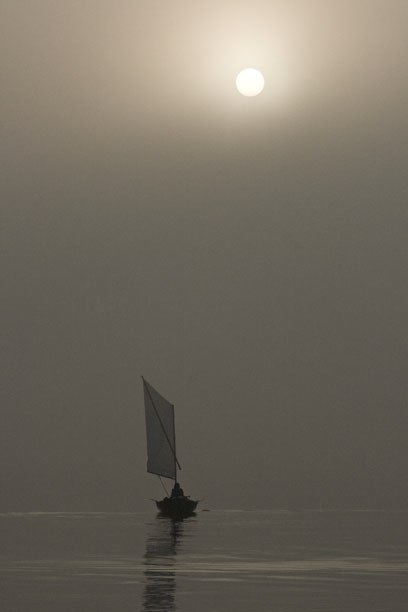 Fog above, Water below, Boats between
Fog above, Water below, Boats between
Random Thought #842:
Air and Water are both fluids – just of very different densities. There’s some limited mixing – clouds, fog, rain, foam – but gravity eventually separates them again, like oil and vinegar.
Ergo:
A boat is made to float precisely at the delicate interface of these two liquid layers, by design more dense than air and less dense than water.
It’s stating the obvious, of course, but it seems quite a tenuous balancing act when you think of it that way. It’s no wonder so many vessels end up at the bottom of the sea or torn to pieces by the wind.
Though there’s not been much to show for it, I’ve actually been quite busy these last several weeks. The framing is at a point where the centerboard case must be installed, as it’s an integral part of the structure, supporting the deck framing. Unfortunately, there is nothing in any set of plans about a centerboard – all the original drawings and modern adaptations call for daggerboards – so I’ve burned up a considerable quantity of brain cells trying to figure out how to go about it.
If you only need to go where the currents in the water go, you don’t need a sail. If you have a sail, and only need to go where the wind is blowing, you don’t need a keel. A keel is to the water what a sail is to the wind – they are mirrors of each other in their respective fluids. The most efficient keel, in fact, is shaped like an airplane wing, as is the most efficient sail, and naval engineers describe the effectiveness of both in terms of “lift,” the same as for the wing of a plane.
I’ve gone through several designs, and built a few models and prototypes, even been making some custom brass hardware, and think I have something that will work now. In truth there’s no way to know for certain until the boats are complete and on the water for the first time, when it will be very difficult to change, so a lot of thought and planning has to go into it to get things right at this point if possible.
A sailboat uses the forces of wind and water against each other to overcome the forces of both. Like two bulls pushing on a gate from opposite directions, each is applying forces on the boat that must be kept in balance – as long as the forces are balanced, the gate stays shut and the bulls stay safely in their respective pens. The trick is to maintain that balance without being blown to tatters or swamped and sunk. It’s a wonder anyone ever thought it would work.
I already discarded a couple of ideas, but some of them are pretty interesting, so I’ll be posting information and pictures about them in the coming days on the chance they turn out useful to someone else.
A centerboard can be both a blessing and a curse. On a small boat, it allows you to sail right up on a beach or into shallow water without fear of damaging your boat – something fixed keel boats can’t even consider. Fixed keels are simple and relatively maintenance free, but in shallow water, or in the presence of submerged objects, they are a boat’s Achilles Heel. A daggerboard is retractable, like a centerboard, but it has to be raised manually. It doesn’t kick up automatically when it hits an obstruction, so it’s not as convenient; but it’s both easier to build and easier to maintain – there’s not much that can go wrong with it.
Centerboards on the other hand, while convenient, are prone to all sorts of annoying little problems. They can be fussy to use, are difficult to design and build, and take up a lot of valuable space inside the boat. They are prone to things like leaking, swelling, getting stuck, breeding rot, etc.. Even so, when they work well they’re a real pleasure to have, and as long as the sacrifices aren’t too great, most people prefer them to the other options.
I designed a centerboard for my first boat, and it has worked well, so I’ll be drawing on that experience, as well as on the work that others have already done, and some new ideas that seem promising.
melonseed skiff, mellonseed skiff, melon seed, mellon seed


